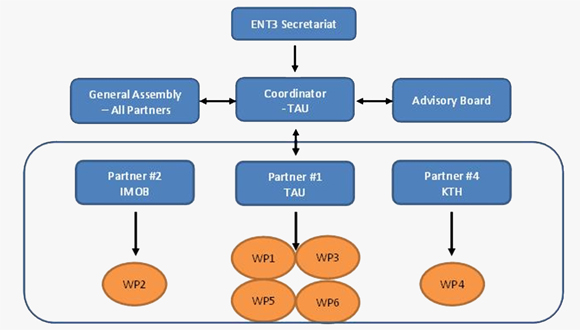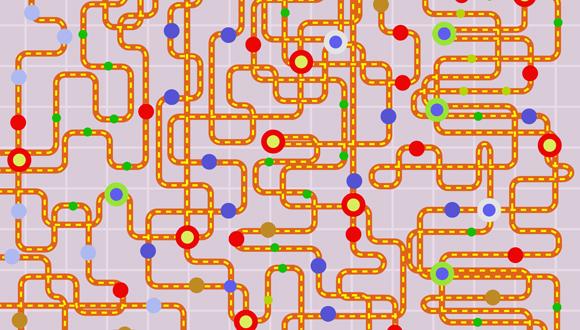Objectives and Work Plan
- Design the concept, structure and laws of functioning for a smart adaptive intermodal PT system.
- Develop algorithms for instantaneous estimation of travel demand based on ICT-data and the mismatch with the existing PT supply
- Develop and test the pathways of gradual and seamless transition from current inflexible PT to a self-aware and evolving intelligent PT system.
- Investigate SMART-PT cost-effectiveness in case studies in several European cities (proof-of-concept).
- Assess the impacts of SMART-PT on end-users and operators
- Suggest changes in regulatory frameworks (EU/national/local) to facilitate SMART PT adoption and implementation.
Project structure and management
Figure 2: Project structure and management

Description: The coordinator of the project if TAU who is responsible to report to the ENT3 secretariat. The coordinator chairs the general assembly and is assisted by an advisory board. Different partners are responsible for different work packages.
Work package descriptions
The project is comprised of 6 work packages (WP).
WP1: Project management.
WP2: SMART-PT Interface
- Determining data structures for flexible PT (demand and supply)
- Establishing data requirements
- Establishing fixed PT networks
WP3: SMART-PT Kernel
- Mining ICT data and analyse accessibility; evaluate Demand-Supply gaps
- Generating Urban Spatial Histories for present and scenarios of Urban Dynamics in the future
- Developing of algorithms (GA) for PT network adaptation
WP4: SMART-PT Sim
- Agent-Based simulation of PT functioning (next generation MATSim)
- Proof-of-concept by analysis and simulation in the case studies
WP5: SMART-PT Policy
- Qualitative assessments of SMART-PT: citizens (incl. mobility impaired), service providers, regulators
- Participatory gaming for stakeholder engagement
- Developing of implementation policies
WP6: Dissemination of project outputs and exploitation of results for future R&D.
The project is expected to have the following impacts:
- Radical changes to the structure of current PT operations and design by generating new hybrids of intermodal public transport modes.
- Exploitation of new ICT opportunities for data acquirement, optimises the use of existing infrastructures without expanding them.
- Fitting the type and operation of services to the demand attributes at a high spatial and temporal resolution bringing significant savings in running costs to service providers.
- Collaborate with users, operators and regulators in the participant’s cities, regions, nations and the EU (through WP5) based on extensive dissemination plan. (WP6). Two annual workshops.
- Future exploitation by submission to Horizon 2020 framework programme’s Transport and or ICT Cooperation Track


